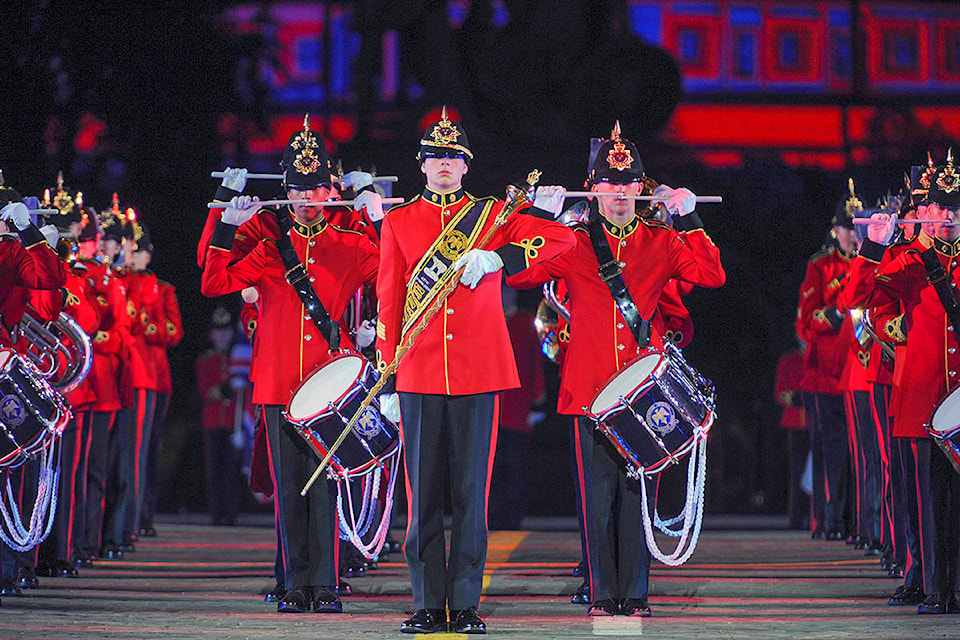During the annual “Tribute to the Veterans” segment of its program, the Okanagan Military Tattoo will commemorate the 75th anniversary of D-Day and the Battle of Normandy.
The segment will honour the sacrifices and achievements of those who fought in that campaign.
The sixth annual Okanagan Military Tattoo takes place on July 27 and 28 at Kal Tire Place in Vernon.
June 6, 2019, marks the 75th anniversary of D-Day and the Battle of Normandy, a day when more than 14,000 Canadian soldiers came ashore at Juno Beach in Nazi occupied France, a day now known to history as D-Day.
The invasion plan called for five infantry divisions to wade ashore along an 80-kilometre stretch of France’s coastline.
READ MORE: Former motorcycle racer looks to create PTSD support group in Okanagan
Three airborne divisions, including the 1st Canadian Parachute Battalion, would precede the invasion to delay enemy movements and help with the expansion of the bridgehead.
The 3rd Canadian Division along with the 2nd Canadian Armoured Brigade were to take part in the seaborne assault.
Two of the division’s three brigades were to take part in the first wave at Juno Beach, which included the Regina Rifles, the Royal Winnipeg Rifles, the Queens Own Rifles of Canada, the North Shore (New Brunswick) Regiment, the Canadian Scottish from Victoria and the Quebec’s Regiment de la Chaudiere.
In the event of a German counterattack, they were to be reinforced by the Highland Light Infantry of Canada, the Stormont Dundas and Glengarry Highlanders, the North Nova Scotia Highlanders and the tanks of the Sherbrooke Fusiliers.
The tanks of the 1st Hussars and the Fort Garry Horse would land ahead of the infantry to soften up the defences and provide covering fire. The guns of the Royal Canadian Artillery would be put ashore quickly to lend additional support.
The combat troops were to be supported by the Royal Canadian Engineers, the Royal Canadian Corps of Signals, the Royal Canadian Medical Corps and the Royal Canadian Army Service Corps.
READ MORE: Federal government invests $10 million towards cervical cancer research
These groups would see that enemy obstacles were removed, communications were possible, the wounded were treated and all were adequately supplied with food, fuel, ammunition and the other necessities of warfare.
Germany, though weakened after five years of fighting on several fronts, especially against the Russians on the Eastern Front were still very dangerous.
The German troops were battle hardened and well led. The German defences were part of Field Marshal Erwin Rommel’s Atlantic Wall, consisting of reinforced concrete pill boxes, barbed wire, mines, artillery, machine gun nests, mortar pits and beach obstacles. Their weapons were equal to or superior to the Allies and included the deadly 88 mm dual purpose antitank/antiaircraft gun and the Panther and Tiger Tanks.
The invasion date was set for June 5, 1944, when the tides were most favourable, however, stormy weather forced a postponement until June 6.
Canadian sailors and airmen were among the first into action.
READ MORE: Scheer vows to make free trade between provinces a reality if Conservatives elected
The RCAF had already been involved for several months in bombing enemy targets and now they flew as part of the 171 squadrons that attacked on D-Day dropping bombs, fighting the Luftwaffe and protecting soldiers on the beach.
The Royal Canadian Navy provided 109 vessels and 10,000 sailors. Canadian Mine Sweepers assisted in the crucial job of clearing a safe path across the English Channel while Canadian Destroyers silenced enemy shore batteries.
Canadian landing craft carried our troops, tanks and equipment to the beaches and returned to the hospital ships with the Canadian wounded. At dawn the Canadian soldiers came ashore, braved heavy fire and established an eight kilometre foothold on the Normandy Coast fronting the villages of Saint-Aubin-sur-Mer, Bernieres-sur-Mer, Courseulles-sur-Mer and Graye-sur-Mer.
After successfully capturing their shoreline positions at Juno Beach, the Canadians penetrated the farthest inland of any of the 155,000 Allied troops who landed on June 6.
D-Day was only the beginning of the struggle to liberate France.
In the days that followed, the Canadians found themselves pitted against elite SS divisions manned by fanatical troops under the command of ruthless and experienced German officers.
The Canadians would bend but not break, however, the memory of the bitter fighting would haunt our veterans for years to come.
READ MORE: Trudeau says carbon tax can help deal with extreme weather, Alberta fires
Victory in the Battle of Normandy came at a terrible cost. The Canadians suffered the highest casualties of any divisions in the British Army Group during the campaign. Some 359 Canadian soldiers were killed on D-Day alone, and more than 5,000 would die during the two-and-a-half months of fighting in Normandy.
For more information about the upcoming Okanagan Military Tattoo, check out the website at www.okanagantattoo.ca.
To report a typo, email:
newstips@kelownacapnews.com.
@KelownaCapNews
newstips@kelownacapnews.com
Like us on Facebook and follow us on Twitter.
